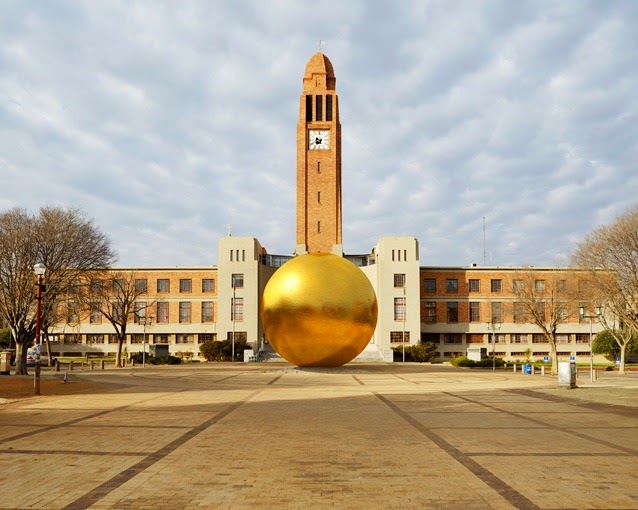South African photographer Dillon Marsh, continues with his photo project “For What It’s Worth” that attempts to quantify mining by visualizing just how much metal a mine can produce using computer generated imagery and actual photos of the mines. Marsh began his project by taking South African copper mines as his subject. Later he started photographing gold mines and recently diamond mines, all located in his home country. Then using data about extraction rates, Marsh calculated the size of a single, solid orb to represent the amount of metal that had been mined in total. Then using a rendering engine and some quick adjustments for scale, Marsh inserted each orb into the landscape. For diamond mines, Marsh shaped the extracted diamonds into a single massive jewel. The immense scale of these open pit mines and the relatively low yield associated with diamond mining make for a dramatic visual comparison.
Central Rand Goldfield
The main gold reef of the Witwatersrand Basin was discovered for the first time on the Langlaagte farm in 1886. This farm and the surrounding region later became known as the Central Rand Goldfield and since the beginning of operations an estimated 250.5 million ounces has been produced.
Klerksdorp Goldfield

The Klerksdorp Goldfield has produced an estimated 229 million ounces of gold since mining operations began in 1941.
East Rand Goldfield
Established in 1887, the East Rand is the second oldest of the Witwatersrand Goldfields. Having produced an estimated 368.7 million ounces of gold to date, it is also the second largest producer of this precious metal amongst these seven goldfields.
Free State Goldfield
Consisting of approximately 18 mines and 53 shafts, the Free State Goldfield has produced an estimated 367 million ounces of gold since mining operations began in 1951.
Kimberley Mine (1871 - 1914) - 14.5 million carats of diamonds extracted
In 1867 a diamond was discovered by a young boy on a farm near Hopetown, in what is now known as South Africa’s Northern Cape province. News of this discovery quickly spread and before long prospectors found several diamond-rich pipes in the region, creating the backbone for bigger towns like Kimberley. Today, the country is one of the world's leading diamond producers.
Koffiefontein Mine (1870 - 2014) - 7.6 million carats of diamonds extracted
Jagersfontein Mine (1871 - 1969) - 9.52 million carats of diamonds extracted
via PetaPixel





















This is crazy! Each one of those mines represents so much money and so much work for so many people! It's very impressive what humans can do when they put their minds together and work hard. A few of these were discovered on accident, but I can't imagine that all mines were discovered that way. Are there people that have tools to search out mines like that? http://www.sub-arctic.ca/whoWeAre.htm
ReplyDelete